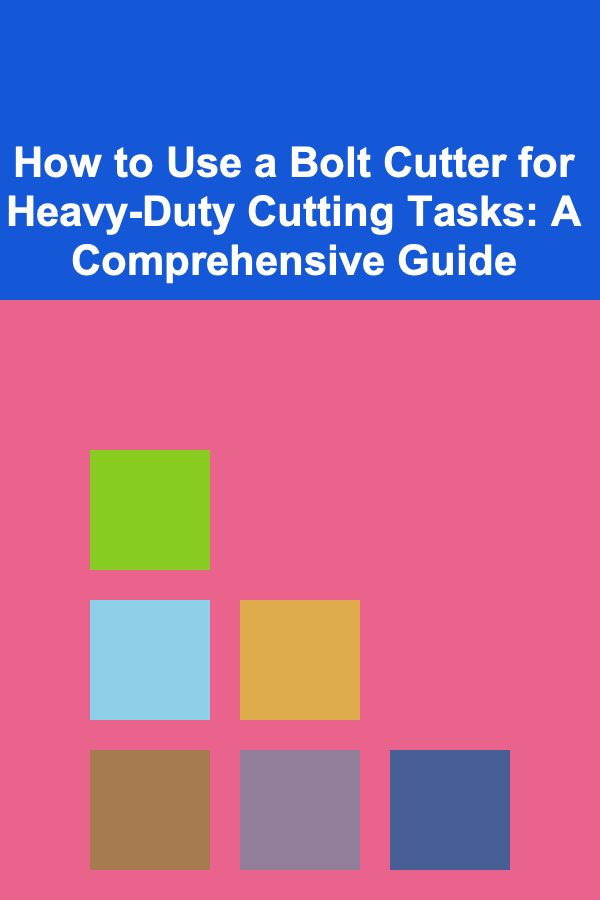
How to Use a Bolt Cutter for Heavy-Duty Cutting Tasks: A Comprehensive Guide
ebook include PDF & Audio bundle (Micro Guide)
$12.99$11.99
Limited Time Offer! Order within the next:

Bolt cutters are indispensable tools for a wide range of heavy-duty cutting tasks, from removing padlocks and chains to cutting rebar and metal rods. Their powerful jaws and leverage-based design allow them to slice through materials that would be impossible to cut with conventional tools like saws or pliers. However, mastering the use of bolt cutters involves understanding their mechanics, selecting the right tool for the job, and employing safe and effective cutting techniques. This comprehensive guide will delve into the intricacies of bolt cutter operation, providing you with the knowledge and skills to tackle demanding cutting projects with confidence.
Understanding Bolt Cutters: Mechanics and Types
Before diving into the practical applications of bolt cutters, it's crucial to understand their fundamental design and the different types available. This knowledge will empower you to choose the most appropriate tool for the specific task at hand and optimize your cutting performance.
The Mechanics of Leverage
The core principle behind bolt cutter operation is leverage. Bolt cutters employ a compound lever system, significantly multiplying the force applied to the handles. This mechanical advantage allows the user to generate immense cutting power with relatively little effort. The jaws are positioned close to the pivot point, while the handles are much longer. This arrangement maximizes the force transferred to the cutting blades, enabling them to shear through tough materials.
Types of Bolt Cutters
Bolt cutters are available in various sizes and configurations, each designed for specific applications. Understanding these variations is essential for selecting the right tool.
- Standard Bolt Cutters: These are the most common type, available in lengths ranging from 14 inches to 42 inches or more. They are suitable for general-purpose cutting tasks, such as cutting chains, bolts, and rods. The longer the handles, the greater the leverage and cutting power.
- Mini Bolt Cutters: These compact cutters are designed for confined spaces and lighter-duty tasks. They are ideal for cutting thinner wires, small bolts, and zip ties. Their small size makes them easy to carry and maneuver.
- Center Cut Bolt Cutters: The blades of center-cut bolt cutters meet directly in the center, providing a clean, flush cut. This design is particularly useful for cutting materials close to a surface.
- Angled Head Bolt Cutters: These cutters feature angled cutting heads, allowing access to awkward or hard-to-reach areas. This is especially useful in automotive or construction environments.
- Cable Cutters: While technically a related tool, cable cutters are specifically designed for cutting cables and wire ropes. Their blades are shaped to grip and cut stranded materials cleanly, preventing fraying. They often have rounded cutting edges compared to the more angular edges of bolt cutters.
Choosing the Right Bolt Cutter for the Job
Selecting the correct bolt cutter is paramount for safety, efficiency, and preventing damage to the tool itself. Consider the following factors when making your selection:
Material Hardness
The hardness of the material you intend to cut is the most critical factor. Bolt cutters are typically rated for the maximum hardness of the materials they can cut effectively. Cutting materials exceeding this rating can damage the blades or even break the tool. Check the manufacturer's specifications for the tool's cutting capacity and material hardness rating. For instance, some bolt cutters are designed for mild steel, while others are capable of cutting hardened steel or even specialized materials like rebar.
Material Diameter
The diameter of the material also plays a crucial role. Bolt cutters have a maximum cutting capacity, which is usually specified in terms of the diameter of a round bar. Attempting to cut materials exceeding this diameter can damage the blades or compromise the cutting performance. Always refer to the tool's specifications before attempting to cut thick materials.
Accessibility
Consider the accessibility of the cutting location. If you need to cut material in a confined space or at an awkward angle, a mini bolt cutter or an angled-head bolt cutter may be the best choice. Standard bolt cutters may be difficult to maneuver in tight spaces.
Frequency of Use
If you anticipate using bolt cutters frequently, invest in a high-quality tool with durable blades and comfortable handles. A well-made bolt cutter will provide years of reliable service. Cheaper models may be less durable and prone to blade damage or handle breakage.
Safety First: Essential Precautions
Using bolt cutters can be hazardous if proper safety precautions are not followed. Always prioritize safety to prevent injuries.
Warning: Always wear appropriate personal protective equipment (PPE) when using bolt cutters. This includes safety glasses or goggles to protect your eyes from flying debris, and gloves to protect your hands from sharp edges.
Eye Protection
Wearing safety glasses or goggles is non-negotiable. When cutting metal, small fragments can be propelled at high speeds. Eye injuries are a serious risk, and proper eye protection is essential to prevent them.
Hand Protection
Wear sturdy gloves to protect your hands from cuts and abrasions. The material being cut may have sharp edges, and the bolt cutter itself can pose a risk of pinching or crushing injuries.
Foot Protection
Consider wearing safety shoes or boots, especially when working on construction sites or other environments where there is a risk of falling objects. Dropped bolt cutters can cause serious foot injuries.
Work Area Safety
Ensure the work area is clear of obstructions and bystanders. Provide adequate lighting to ensure you can clearly see the material you are cutting. A cluttered or poorly lit work area increases the risk of accidents.
Proper Stance and Grip
Maintain a stable stance and grip the handles firmly. Avoid overreaching or cutting in awkward positions. A secure grip is crucial for controlling the tool and preventing slippage.
Cutting Technique
Use a controlled and deliberate cutting motion. Avoid jerking or forcing the tool, as this can damage the blades or cause the material to slip. Let the leverage of the bolt cutter do the work.
Inspecting the Tool
Before each use, inspect the bolt cutter for any signs of damage, such as loose handles, chipped blades, or worn pivot points. Do not use a damaged tool. Regular inspection helps prevent tool failure and ensures safe operation.
Step-by-Step Guide to Using Bolt Cutters
Now that you understand the mechanics, types, and safety precautions, let's walk through the process of using bolt cutters effectively.
1. Prepare the Work Area
Clear the area of any obstructions and ensure you have adequate lighting. Place the material you intend to cut on a stable surface or secure it in a vise if possible. This will prevent the material from moving during the cutting process.
2. Position the Bolt Cutter
Open the jaws of the bolt cutter wide enough to accommodate the material you are cutting. Position the material as close to the pivot point of the jaws as possible. This maximizes the leverage and cutting power. Avoid placing the material at the tips of the blades, as this can lead to bending or chipping.
3. Apply Pressure
Grip the handles firmly and apply steady, even pressure. Avoid jerking or forcing the tool. Let the leverage of the bolt cutter do the work. If the material is particularly tough, you may need to apply more force gradually. Forcing the tool can lead to blade damage or injury.
4. Complete the Cut
Continue applying pressure until the material is completely severed. Be prepared for the material to snap or fly apart when the cut is complete. Maintain a firm grip on the bolt cutter to prevent it from slipping.
5. Inspect the Cut
Examine the cut to ensure it is clean and complete. If the cut is ragged or incomplete, reposition the bolt cutter and apply more pressure. Avoid repeatedly cutting the same spot, as this can damage the blades.
Tips and Tricks for Efficient Cutting
Here are some additional tips and tricks to enhance your bolt cutter skills:
Lubricate the Blades
Regularly lubricate the blades with a light oil to reduce friction and prevent rust. This will also improve the cutting performance and extend the life of the tool. A well-lubricated bolt cutter requires less effort to operate.
Sharpen the Blades
Dull blades can make cutting difficult and increase the risk of injury. Sharpen the blades periodically using a file or sharpening stone. Follow the manufacturer's instructions for sharpening the blades.
Use a Vise
When cutting small or awkward-shaped materials, use a vise to hold the material securely in place. This will free up your hands and make the cutting process easier and safer.
Cutting Hardened Materials
When cutting hardened materials, use a bolt cutter specifically designed for that purpose. Avoid using standard bolt cutters, as they may not be able to handle the hardness of the material and can be damaged. For very hard materials, consider using an angle grinder with a cut-off wheel as a safer alternative if you are experienced with using one.
Avoiding Blade Damage
Avoid cutting materials that are too hard or too thick for the bolt cutter. This can damage the blades and render the tool unusable. Always check the manufacturer's specifications before attempting to cut a new material.
Proper Storage
Store bolt cutters in a dry place to prevent rust. Consider hanging them on a wall or storing them in a toolbox. Protecting the blades from damage will prolong their lifespan.
Troubleshooting Common Problems
Even with proper technique, you may encounter some common problems when using bolt cutters. Here are some solutions:
Blades Won't Cut
If the blades are not cutting effectively, they may be dull or damaged. Sharpen or replace the blades as needed. Also, ensure that the material you are cutting is within the tool's cutting capacity.
Handles Are Difficult to Close
If the handles are difficult to close, the pivot point may be dry or corroded. Lubricate the pivot point with a light oil. Also, check for any obstructions that may be hindering the movement of the handles.
Material Slips
If the material slips during cutting, ensure that the jaws are positioned correctly and that you are applying even pressure. Using a vise to secure the material can also prevent slippage.
Blades Chip or Break
If the blades chip or break, it is likely that you are cutting a material that is too hard or too thick for the tool. Replace the blades and choose a bolt cutter with a higher cutting capacity for future tasks.
Bolt Cutters vs. Other Cutting Tools
It's important to understand when a bolt cutter is the right tool for the job compared to alternatives like hacksaws, angle grinders, or reciprocating saws. Each tool has its strengths and weaknesses.
Bolt Cutters vs. Hacksaws
Hacksaws are better for more precise cuts and are often preferred when dealing with softer metals or plastics where a clean, burr-free edge is required. Bolt cutters excel at quickly severing thicker, harder materials like chains and padlocks. Hacksaws require significantly more manual effort and time.
Bolt Cutters vs. Angle Grinders
Angle grinders offer unparalleled cutting power and can handle extremely hard materials like hardened steel and thick rebar. However, they are much louder, produce a lot of sparks, and require more experience and safety precautions to operate. Bolt cutters are quieter, produce no sparks, and are generally safer for less experienced users, but they are limited by the hardness and thickness of the material they can cut. Grinders are also better for cutting shapes and angles.
Bolt Cutters vs. Reciprocating Saws (Sawzalls)
Reciprocating saws are versatile tools that can cut through a wide range of materials, including wood, metal, and plastic. They are particularly useful for demolition work and cutting materials that are difficult to access. However, they are not as efficient as bolt cutters for cutting chains and bolts. Bolt cutters provide a cleaner, more precise cut with less vibration.
In summary, bolt cutters are ideal for quickly and efficiently cutting chains, bolts, padlocks, and similar materials where precision is not paramount and the material hardness is within the tool's capacity. When greater precision, harder materials, or shaping are needed, other tools like hacksaws, angle grinders, or reciprocating saws may be more appropriate.
Maintenance and Care
Proper maintenance is crucial for ensuring the longevity and performance of your bolt cutters.
- Cleaning: After each use, clean the blades and handles with a clean cloth to remove any dirt, debris, or residue.
- Lubrication: Regularly lubricate the pivot points and blades with a light oil to prevent rust and ensure smooth operation.
- Sharpening: Sharpen the blades periodically to maintain their cutting edge. Use a file or sharpening stone, following the manufacturer's instructions.
- Storage: Store bolt cutters in a dry place, away from moisture and extreme temperatures. Consider hanging them on a wall or storing them in a toolbox.
- Inspection: Regularly inspect the tool for any signs of damage, such as loose handles, chipped blades, or worn pivot points. Replace any damaged parts immediately.
Conclusion
Bolt cutters are powerful and versatile tools that can significantly simplify a variety of heavy-duty cutting tasks. By understanding their mechanics, selecting the right tool for the job, prioritizing safety, and employing proper cutting techniques, you can harness the full potential of bolt cutters and tackle demanding projects with confidence. Remember to regularly maintain your tool to ensure its longevity and optimal performance. While seemingly simple, mastering the art of using bolt cutters effectively requires attention to detail, a commitment to safety, and a solid understanding of the tool's capabilities and limitations. Embrace these principles, and you'll be well-equipped to handle a wide range of cutting challenges.

How to Build an E-commerce Business Without Huge Startup Costs
Read More
How to Depersonalize Your Space for Better Buyer Impressions
Read More
How to Design the Ultimate Backyard BBQ Party at Home
Read More
How to Inspect and Maintain Your Home's Plumbing Fixtures and Faucets
Read More
How to Store Craft Tools Safely and Securely
Read More
How to Choose an Anesthesiologist: Key Considerations
Read MoreOther Products

How to Build an E-commerce Business Without Huge Startup Costs
Read More
How to Depersonalize Your Space for Better Buyer Impressions
Read More
How to Design the Ultimate Backyard BBQ Party at Home
Read More
How to Inspect and Maintain Your Home's Plumbing Fixtures and Faucets
Read More
How to Store Craft Tools Safely and Securely
Read More